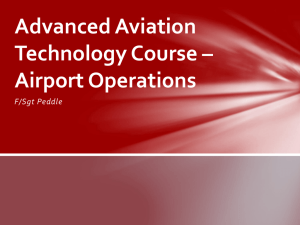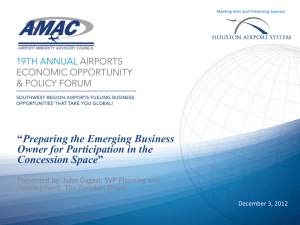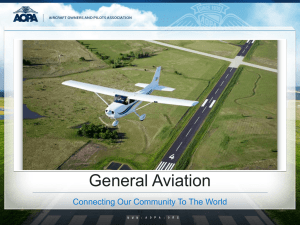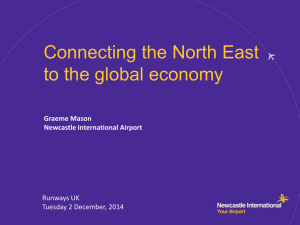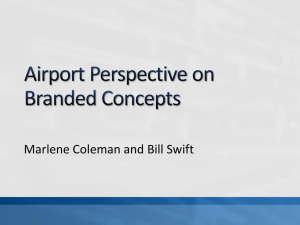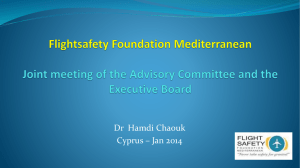Federal Update - Georgia Airports Association
advertisement
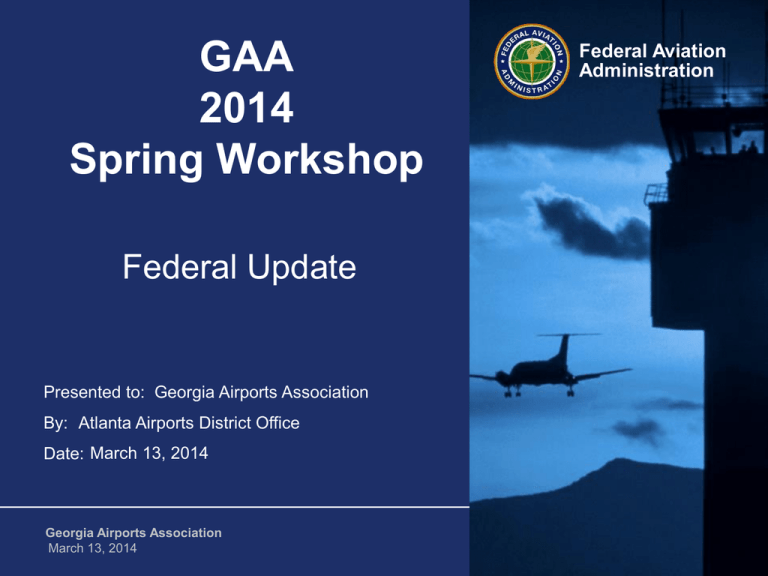
GAA 2014 Spring Workshop Federal Aviation Administration Federal Update Presented to: Georgia Airports Association By: Atlanta Airports District Office Date: March 13, 2014 Georgia Airports Association March 13, 2014 Federal Aviation Administration 1 Federal Update Georgia Block Grant FY 2014 AIP Program FY 2015 AIP Program Georgia AIP Funding Odds & Ends Economic Development at Obligated Airports Georgia Airports Association March 13, 2014 Federal Aviation Administration 2 Georgia Block Grant ATL-ADO – Issues grants to Primary Airports (ABY, AGS, ATL, BQK, CSG, SAV, VLD) and the Georgia Block Grant to GDOT. We are their service point for all AIP issues. GDOT – Issues sub-grants to all General Aviation Airports and are their service point for all AIP issues. Georgia Airports Association March 13, 2014 Federal Aviation Administration 3 FY 2014 AIP Program Update H.R. 3547 - $3.35B obligation limit ($3.194B for grants) Prohibits funds from being spent on baggage system modifications for EDS machine installation. Provides for 95% Federal share for FY14 small airport construction projects that are a phase of a construction project begun in FY11. Georgia Airports Association March 13, 2014 Federal Aviation Administration 4 FY 2014 AIP Program Update Provides for 95% Federal share for Essential Air Svc. (EAS) and Economically Distressed Areas (EDA). Provides minimum amount of NPE funds of $1M for airports serving large air carriers with at least 10,000 annual enplanements (scheduled or unscheduled) (Sec. 47114(c), "large carrier provision") Georgia Airports Association March 13, 2014 Federal Aviation Administration 5 FY 2014 AIP Program Schedule All Airports Submitted Their Annual CIP’s in January 2013 ADO Established 2014 AIP Program in April 2013 ADO PM’s currently conducting Pre-Grant Conferences Work with ADO PM on Bidding schedules First Grants – Approx. May 15th Georgia Airports Association March 13, 2014 Federal Aviation Administration 6 FY 2015 AIP Program Schedule CIP Call Letter Issued in October 2013 (Jan. 1 submittal) ADO PM’s are Currently Scrubbing April – Selection of Projects & Disc. Program We Continue to Encourage Prior-year Design Georgia Airports Association March 13, 2014 Federal Aviation Administration 7 million Georgia AIP Funding 50 45 40 35 30 25 20 15 10 5 0 Entitlements Discretionary 2011 Georgia Airports Association March 13, 2014 2012 2013 2014 Federal Aviation Administration 8 Odds & Ends New AIP Handbook (FAA Order 5100.38) • Draft is currently available – www.faa.gov/airports/aip/aip_handbook Airports Division SOP’s (23 total) • Exhibit “A”, ALP, Construction Safety Phasing Plans AC 150/5300-13A, Change 1, 2/26/14 • Primarily includes updates to the standards for Taxiway Fillet Design • New Approach and Departure Reference Code (APRC and DPRC) designations replace Runway Reference Code (RRC). Georgia Airports Association March 13, 2014 Federal Aviation Administration 9 Odds & Ends ARP Digitization • Electronic Docs A&E, and Planning Consultant Services For Airport Grant Projects, AC 150/5100-14 • Update underway SAMS/DUNS/CCR • Keep up to date Georgia Airports Association March 13, 2014 Federal Aviation Administration 10 Economic Development at Obligated Airports Self Sustainability Revenue Diversion Land Releases Review of Non-Aeronautical Leases RPZ Policy Planning and Environmental Requirements Ensuring Safe Approaches at Your Airport Development Proposal Considerations Georgia Airports Association March 13, 2014 Federal Aviation Administration 11 Grant Assurance 24 – Fee and Rental Structure Federal Aviation Administration Self-sustainability Presented to: Georgia Airports Association By: Atlanta Airports District Office Date: March 13, 2014 Georgia Airports Association March 13, 2014 Federal Aviation Administration 12 Grant Assurance 24 - Fee and Rental Structure – It will maintain a fee and rental structure for the facilities and services at the airport which will make the airport as self-sustaining as possible under the circumstances existing at the particular airport, taking into account such factors as the volume of traffic and economy of collection. Georgia Airports Association March 13, 2014 Federal •13 Aviation Administration 13 Self Sustainability Legislative History – Section 511(a)(9) of the Airport and Airway Improvement Act of 1982. – Codified in 49 USC § 47107(a)(13) – Section 112(a) of the Federal Aviation Administration Authorization Act of 1994. – Amended 49 U.S.C. § 47107(l) to require FAA’s Policy and Procedures Concerning the Use of Airport Revenues to take into account whether sponsors – when entering into new or revised agreements otherwise establishing rates, charges, and fees – have undertaken reasonable efforts to be self sustaining in accordance with 49 U.S.C. § 47107(a)(13). Georgia Airports Association March 13, 2014 Federal •14 Aviation Administration 14 Self-sustainability Self-sustaining Principle – Each Federally assisted airport owner/operator is required by statue and grant assurance to have an airport fee and rental structure that will make the airport as self-sustaining as possible under the particular airport circumstances, in order to minimize the airport’s reliance on Federal funds and local tax revenues. • Recognizes that individual airports may differ in their abilities to be self-sustaining. • Maintains the utility of the Federal investment in the airport. Georgia Airports Association March 13, 2014 Federal •15 Aviation Administration 15 Self-sustainability Airport Circumstances – Recognizes that market conditions at some airports may not permit the sponsor to establish fee’s sufficiently high enough to recover aeronautical costs and sufficiently low enough to attract and retain commercial aeronautical services. – Sponsor’s decision to charge rates that are below those needed to achieve self-sustainability in order to assure that services are provided to the public is not inherently inconsistent with the federal obligation to make the airport as self-sustaining as possible given its particular circumstances. Georgia Airports Association March 13, 2014 Federal •16 Aviation Administration 16 Self-sustainability Airport Circumstances –Aeronautical Rates Potential GA 24 Conflict Potential GA 22(a) Conflict Cost Recovery Attraction Potential GA 22(a) Conflict Georgia Airports Association March 13, 2014 Potential GA 24 Conflict Federal •17 Aviation Administration 17 Self-sustainability - Aeronautical • Rates and Charges for the use of the airfield generally may not exceed the airports capital and operating costs of providing the airfield. • Aeronautical fees for landside or non-movement area airfield facilities (e.g. hangars and aviation offices) may be at a fair market rate, but are not required to be higher than a level that reflects the cost of services and facilities. (i.e. somewhere between cost and Fair Market Value), • The FAA will not ordinarily investigate the reasonableness of a general aviation airport’s fees absent evidence of a progressive accumulation of surplus aeronautical revenues. Georgia Airports Association March 13, 2014 Federal •18 Aviation Administration 18 Self-sustainability – Non-aeronautical • The grant assurances do not prohibit an airport owner from using airport property for nonaeronautical revenue production. – (Some Surplus Property Deed Restrictions and Sec. 16/23 conveyances do prohibit non-aeronautical use) • The prime obligation of the owner of a federally assisted airport is to provide a facility to serve the public’s interest in aviation. – This overrides the use of airport property for non-aeronautical purposes. • Surplus non-aeronautical revenues can be used to subsidize aeronautical costs of the airport. (Not vice versa!!!) Georgia Airports Association March 13, 2014 Federal •19 Aviation Administration 19 Self-sustainability – Non-aeronautical • For non-aeronautical uses the FAA requires: • The airport receive Fair Market Value (FMV) rents. Georgia Airports Association March 13, 2014 Federal •20 Aviation Administration 20 What is Fair Market Value (FMV)? The cash price that a property would most likely sell for in the market, assuming that it has a reasonable time for exposure on that market and assuming it is offered for sale by a knowledgeable owner - the seller- who is willing but not obligated to sell to a knowledgeable purchaser who is willing but not obligated to buy. To be at FMV, the Property Sale/Lease Must Be: Arms Length Transaction (Knowledgeable Buyer and Seller are independent of one another, no undue influence exerted by either party or by any other source). Adequately exposed “For Sale/Lease” on the market (all terms and conditions disclosed) For the Real Property Only. No side deals for other property, loans, personal property, other debts between the parties, etc.. For Cash Payment or Equivalent and For Clear Title to the Land. An Appraiser Analyzes and Documents the Property and Market Sale/Lease Conditions to Appraise the FMV of a Property Georgia Airports Association March 13, 2014 Federal Aviation Administration 21 Self-sustainability – Non-aeronautical • Fair Market Value (FMV) – FMV appraisal (typically required for long term nonaero leases and significant non-aero use/development) • FAA Advisory Circular (AC) 150/5100-17 CHG 6, Land Acquisition and Relocation Assistance for Airport Improvement Program (AIP) Assisted Projects, • Uniform Standards of Professional Appraisal Practice (USPAP), • Uniform Appraisal Standards for Federal Land Acquisition (UASFLA). – Restricted Use Appraisals are not acceptable!! – FMV lease rate is determined by multiplying the capitalization rate by the appraised fee simple FMV. • Capitalization rates typically range from 6-12% Georgia Airports Association March 13, 2014 Federal •22 Aviation Administration 22 Rate Structures 12% Capitalization Rate ↑ Non-Aero Leases ↓ 6% Capitalization Rate Fair Market Value (FMV) – Non Aeronautical Rates ↑ Aeronautical Rates Nominal Value Georgia Airports Association March 13, 2014 Federal Aviation Administration 23 Self-sustainability Most Common Issues: Failure to obtain fair market rental value for nonaeronautical uses of airport property, No appraisals/Restricted Use appraisals Aeronautical Revenue Surplus Cost-free use of airport land by the airport owner (normally local city or county) (Below FMV use by the airport owner could also be considered revenue diversion) Georgia Airports Association March 13, 2014 Federal •24 Aviation Administration 24 Resources FAA’s Airport Compliance Program http://www.faa.gov/airports/airport_compliance/ FAA Order 5190.6B, Chapters 17 & 18 Grant Assurances FAA’s Policy Regarding Airport Rates and Charges (September 10, 2013) FAA’s Policy and Procedures Concerning the Use of Airport Revenue (February 16, 1999) Georgia Airports Association March 13, 2014 Federal Aviation Administration 25 FAA Southern Region Chuck Garrison Airports Program Manager 404-305-6723 Georgia Airports Association March 13, 2014 Federal Aviation Administration 26 Grant Assurance 25 – Airport Revenues Federal Aviation Administration Permitted and Prohibited Uses of Airport Revenues Presented to: Georgia Airports Association By: Atlanta Airports District Office Date: March 13, 2014 Georgia Airports Association March 13, 2014 Federal Aviation Administration 27 Grant Assurance 25: Airport Revenues • All revenues generated by the airport and any local taxes on aviation fuel established after December 30, 1987, will be expended by it for the capital or operating costs of the airport; the local airport system; or other local facilities which are owned or operated by the owner or operator of the airport and which are directly and substantially related to the actual air transportation of passengers or property; or for noise mitigation purposes on or off the airport. Georgia Airports Association March 13, 2014 Federal •28 Aviation Administration 28 Federal Law and Policy Airport & Airway Improvement Program of 1982 Airport & Airway Safety & Capacity Expansion Act of 1987 FAA Authorization of 1994 FAA Reauthorization Act of 1996 FAA Modernization & Reform Act of 2012 Georgia Airports Association March 13, 2014 Federal Aviation Administration 29 Federal Law and Policy Codified at 49 U.S.C. § 47107(b) and § 47133 FAA’s Policy and Procedures Concerning the Use of Airport Revenue (February 16, 1999) Grant Assurance 25 FAA Order 5190.6B, Airport Compliance Manual, Chapters 15 & 16 Georgia Airports Association March 13, 2014 Federal Aviation Administration 30 Rate Structures 12% Capitalization Rate ↑ Non-Aero Leases ↓ 6% Capitalization Rate Fair Market Value (FMV) – Non Aeronautical Rates ↑ Aeronautical Rates Nominal Value Georgia Airports Association March 13, 2014 Federal Aviation Administration 31 What is Airport Revenue? Revenues paid to or due to the airport for the use of airport property (fees, charges, rents, etc). Revenue from the sale of property and resources (including mineral, natural, or agricultural products or water taken from the airport).*** Revenue from state and local taxes on aviation fuel (except taxes in effect on December 30, 1987). Georgia Airports Association March 13, 2014 Federal Aviation Administration 32 Permitted Uses of Airport Revenue An airport may use its revenues for the capital and operating costs of the airport, the local airport system, or other local facilities owned and operated by the airport owner or operator and directly and substantially related to the air transportation of passengers or property. Airport employee salaries Lobbying and attorneys fees Utilities Repayment of the sponsor*** Marketing the airport Local AIP match Costs incurred by government officials*** Insurance General government costs*** Georgia Airports Association March 13, 2014 Federal Aviation Administration 33 Prohibited Use of Airport Revenue Direct or indirect payments which exceed the value of services/goods received by the airport. General economic development, marketing, and promotional activities unrelated to the airport. Payments in lieu of taxes, impact fees, or other assessments that exceed the value of services provided. Payments to compensate nonsponsoring governmental bodies for lost tax revenues. Georgia Airports Association March 13, 2014 Federal Aviation Administration 34 Prohibited Use of Airport Revenue Loans to or investment of airport funds in a state or local agency at less than the prevailing rate of interest. Land rental to or use of land by the sponsor for nonaeronautical purposes at less than FMV. Use of land by the sponsor for aeronautical purposes rentfree or for nominal value.*** Community activities/events for community purposes. Direct subsidy to air carrier operations Georgia Airports Association March 13, 2014 Federal Aviation Administration 35 Most Common Violations: Cost allocation plans which overcharge the airport and subsidize other municipal operations. Not charging FMV for nonaeronautical activities. Using airport property for other municipal activities (animal shelters, firing ranges, jails, vehicle or equipment storage, etc.) without compensating the airport at FMV. Poorly structured air carrier incentive programs which inadvertently subsidize air carriers. Selling airport land and not compensating the airport. Georgia Airports Association March 13, 2014 Federal Aviation Administration 36 Permitted v. Prohibited 100% of the salaries & benefits for full time, dedicated airport employees Georgia Airports Association March 13, 2014 100% of the salaries & benefits for city employees who spend only 25% of their time on airport issues Federal Aviation Administration 37 Permitted v. Prohibited Sponsor charges a nominal lease rate to a nonprofit aviation museum on the airport. Sponsor charges itself a nominal lease rate to use airport land for its emergency operations call center. Sponsor charges the Air National Guard unit a nominal rate for its leasehold. Sponsor enters into a $1 per year lease with the county for a golf course. Georgia Airports Association March 13, 2014 Federal Aviation Administration 38 Permitted v. Prohibited The county’s HR department does all hiring and personnel actions for the airport, so the airport pays an amount porportionate to its percentage of airport employees. Georgia Airports Association March 13, 2014 The county’s HR department provides no services to the airport, but charges the airport 10% of their costs as an administrative fee. Federal Aviation Administration 39 Permitted v. Prohibited Costs associated with sending members of the airport commission to DC to meet with the FAA and attend a AAAE conference. Lobbying fees for an AIP project. Attorney fees for a lawsuit filed against a project at the airport. Georgia Airports Association March 13, 2014 Costs associated with sending members of the airport commission to China to promote trade. Lobbying fees for a highway project. Attorney fees for a lawsuit filed against the sanitation department Federal Aviation Administration 40 Permitted v. Prohibited Membership in the local Funding an airport chamber of commerce. operator’s float that has no reference to the airport in a New Year’s Day Parade. Contribution to a golf tournament sponsored by the “Friends of the Airport” committee. Georgia Airports Association March 13, 2014 The airport contributes $50,000 for the city’s film festival. Federal Aviation Administration 41 Permitted v. Prohibited Marketing or promotional costs which promote: - the airport - airport facilities and services - services provided by airport vendors - new service and competition at the airport Georgia Airports Association March 13, 2014 Destination marketing General tourism marketing Federal Aviation Administration 42 Permitted v. Prohibited Georgia Airports Association March 13, 2014 Federal Aviation Administration 43 Permitted v. Prohibited The airport develops a oneyear air carrier incentive program which waives landing fees to air carriers providing new service to a specific destination identified by the airport. The sponsor uses parking revenues to pay for the incentive. Georgia Airports Association March 13, 2014 The airport uses landing fees to pay a discount carrier to provide service to the airport. Federal Aviation Administration 44 Repayment of Sponsor Contributed Funds Airport revenue MAY be used to repay or reimburse an airport sponsor’s contribution to the airport if the sponsor makes the request for reimbursement within six (6) years of the date on which it made the contribution. A sponsor may only claim interest from the date the FAA determines the sponsor is entitled to interest. If the contribution is structured and documented as a loan at the time it is made, the FAA may permit repayment over a longer period, with interest. Georgia Airports Association March 13, 2014 Federal Aviation Administration 45 Community Use of Airport Property 1. The property is not needed for an aeronautical purpose; 2. The use enhances community relations; 3. Does not adversely affect the capacity, security, safety, or operations at the airport; 4. The property involved would not reasonably be expected to produce more than de minimis revenue; 5. Community use does not preclude reuse of the property for airport purposes; and 6. Airport revenue is not used to support the capital or operating costs associated with the community use. (All conditions must be met) Georgia Airports Association March 13, 2014 Federal Aviation Administration 46 Transit Projects An airport sponsor may charge less than FMV for public transit terminals, right-of-way, and related facilities if: 1. The transit system is publically owned and operated; AND 2. The facilities are directly and substantially related to the air transportation of passengers or property. Georgia Airports Association March 13, 2014 Federal Aviation Administration 47 Ground Access Projects A sponsor may use airport revenue to pay for the airport’s share of a ground access project if: 1. The project qualifies as an integral part of an airport capital project; AND 2. If the project is owned or operated by the sponsor and is directly and substantially related to the air transportation of passengers and property. Georgia Airports Association March 13, 2014 Federal Aviation Administration 48 Private Transit Systems Generally – charged FMV as a nonaeronautical use Rarely – in cases where publicly-owned transit services are extremely limited and a private transit service provides the primary source of transportation to the public, making land available at less than FMV may be ok. Georgia Airports Association March 13, 2014 Federal Aviation Administration 49 Lawful Diversion of Airport Revenue Grandfathered obligations Airport privatization program (49 U.S.C. § 47134) Certain sale proceeds from the sale of a privately owned airport to a public sponsor Certain revenue derived from or generated by mineral extraction, production, lease, etc. Georgia Airports Association March 13, 2014 Federal Aviation Administration 50 Penalties for Unlawful Diversion of Airport Revenue • Repayment with interest • Withholding approval of an application for future grants • Withholding modification of existing grants • Withholding payment under existing grants • Withholding approval of a PFC request • Withholding any amount from funds otherwise available to the sponsor from DOT (i.e., transit or highway grants) Georgia Airports Association March 13, 2014 Federal Aviation Administration 51 Penalties for Unlawful Diversion of Airport Revenue File suit for enforcement in the U.S. District Court Exercise reversionary interests and take title to all or any part of property conveyed by the federal government Seek civil penalties of up to three times the amount diverted – treble damages Georgia Airports Association March 13, 2014 Federal Aviation Administration 52 Resources FAA’s Airport Compliance Program http://www.faa.gov/airports/airport_compliance/ FAA Order 5190.6B, Chapters 15 & 16 Grant Assurances FAA’s Policy and Procedures Concerning the Use of Airport Revenue (February 16, 1999) Air Carrier Incentive Program Guidebook Georgia Airports Association March 13, 2014 Federal Aviation Administration 53 FAA Southern Region Chuck Garrison Airports Program Manager 404-305-6723 Georgia Airports Association March 13, 2014 Federal Aviation Administration 54 GAA 2014 Spring Workshop Federal Aviation Administration Land Releases Presented to: Georgia Airports Association By: Atlanta Airports District Office Date: March 13, 2014 Georgia Airports Association March 13, 2014 Federal Aviation Administration 55 Land Releases Georgia Airports Association March 13, 2014 Federal Aviation Administration 56 Land Releases Definition “Release” is defined as the formal, written authorization discharging and relinquishing the FAA’s right to enforce an airport’s contractual obligations. Georgia Airports Association March 13, 2014 Federal Aviation Administration 57 Land Releases Grant Assurance 5 Preserving Rights and Powers Secretary of State approval required for: – Sell – Lease – Encumber or otherwise transfer or dispose of title or other entrance of property shown on Exhibit A (Keep Exhibit “A” updated!) Georgia Airports Association March 13, 2014 Federal Aviation Administration 58 Land Releases Grant Assurance 31 Disposal of Land Airport will dispose of land no longer needed for intended purpose • noise compatibility • Development Disposition subject to maintaining interest/rights ensuring use is compatible with airport noise levels Georgia Airports Association March 13, 2014 Federal Aviation Administration 59 Land Releases Grant Assurance 31 Disposal of Land Land is considered needed if: • Can be used for aeronautical purposes (including RPZ) or as noise buffer • Revenue contributes to financial self-sufficiency of airport Georgia Airports Association March 13, 2014 Federal Aviation Administration 60 Land Releases FAA Airport Compliance Manual FAA Order 5190.6B Chapter 22 Releases from Federal Obligations • • • • Laws Regulations Policies Procedures Georgia Airports Association March 13, 2014 Federal Aviation Administration 61 Land Releases Dedicated or Obligated Property • Property described in agreement • Airport layout plan (ALP) • Exhibit A Property Map AIP and/or surplus or non-surplus property is federal obligated in perpetuity Georgia Airports Association March 13, 2014 Federal Aviation Administration 62 Land Releases Types of Federally Obligated Land • • • • Aeronautical use Conveyance of federal land Acquisition with federal revenue Designated ALP – Regardless of purpose Georgia Airports Association March 13, 2014 Federal Aviation Administration 63 Land Releases Types of Release Request • Change in use, operation or designation of on-airport property • Release and removal of property from airport dedicated use Georgia Airports Association March 13, 2014 Federal Aviation Administration 64 Land Releases Continuing Requirements for Disposals of Airport Property • Right of Flight • Restriction on Released property – Prohibit objects, grown or built, that would be an obstruction to air navigation – Prohibit activity that would interfere with flight of aircraft Georgia Airports Association March 13, 2014 Federal Aviation Administration 65 Land Releases Sponsor Submittal Requirements • • • • • • • • Airport's obligating agreements Legal description – Word format Current Appraisal – Fair Market Value ( <1 year) Type requested (fee simple vs. easement) Justification (Facts and circumstances) How request is consistent with the approved ALP Present condition/use of the property Proposed use of the land Georgia Airports Association March 13, 2014 Federal Aviation Administration 66 Land Releases Sponsor Submittal Requirements • Commitment proceeds use exclusively on airport • Expected use of sale proceeds • List federal obligations land must be released from • Environmental analysis as required by FAA Order 5050.4B • Commitment to update ALP/ Exhibit A Georgia Airports Association March 13, 2014 Federal Aviation Administration 67 Land Releases FAA Review of Release Request “Prime Concern” Benefit to Civil Aviation –Future Growth in Operations • Capacity of the airport • Interest of aeronautical users and service providers • Local, regional and national interest of the airport Georgia Airports Association March 13, 2014 Federal Aviation Administration 68 GAA 2014 Spring Workshop Federal Aviation Administration Non-Aeronautical Leases Presented to: Georgia Airports Association By: Atlanta Airports District Office Date: March 13, 2014 Georgia Airports Association March 13, 2014 Federal Aviation Administration 69 Non-Aeronautical Leases Georgia Airports Association March 13, 2014 Federal Aviation Administration 70 Non-Aeronautical Leases The prime obligation a federally assisted airport owner is to serve the public’s interest in aviation. AIP Grant assurances do not prohibit the leasing of airport property for non-aeronautical revenue production. Note, prospective aeronautical tenants willing to lease property shows a need of the public for the aeronautical services. Georgia Airports Association March 13, 2014 Federal Aviation Administration 71 Non-Aeronautical Leases • Must receive FAA/GDOT concurrence prior to lease execution • Sponsor must demonstrate that all aeronautical users have been accommodated. • Lease must contain reversion clause in case the property is needed for aeronautical purposes Georgia Airports Association March 13, 2014 Federal Aviation Administration 72 Non-Aeronautical Leases • Proposed location must be on area designated for non-aero use (otherwise a release is required • Leases must have Non-transferable clause • Leases must have Escalation clause • Must be identified on the ALP Georgia Airports Association March 13, 2014 Federal Aviation Administration 73 Non-Aeronautical Leases Municipal and Community/Charitable Land Use • non-aero lease agreement • No free Rent! – Must pay rent at FMV – Show how airport benefits at a reduced FMV – Fire & Police have some offsetting value Georgia Airports Association March 13, 2014 Federal Aviation Administration 74 Non-Aeronautical Leases Non-Aeronautical Lease Rates • Must be at or above Fair Market Value (FMV) – Appraisals (< 1 year old) – Competitive Solicitation (RFP) • Consistent with Policy Regarding the Airport Rates and Charges • Make the Airport as self-sustaining as possible • Consistent with Policy Regarding the Use of Airport Revenues (Sponsor Use). • non-aero rents & charges can be used to subsidize aeronautical costs Georgia Airports Association March 13, 2014 Federal Aviation Administration 75 Non-Aeronautical Leases Non-aeronautical Uses of Airport Resources • Airport resources should not be used to support the aeronautical activities unless there is a means for the airport to recover these costs. • Lawn care • Irrigation • Leasehold improvements • Maintenance • Trash removal Georgia Airports Association March 13, 2014 Federal Aviation Administration 76 GAA 2014 Spring Workshop Federal Aviation Administration RPZ Runway Protection Zone Presented to: Georgia Airports Association By: Atlanta Airports District Office Date: March 13, 2014 Georgia Airports Association March 13, 2014 Federal Aviation Administration 77 RPZ Runway Protection Zone Georgia Airports Association March 13, 2014 Federal Aviation Administration 78 Runway Protection Zone (RPZ) Definition The RPZ’s function is to enhance the protection of people and property on the ground! Trapezoidal shaped/Function of aircraft approach category and approach visibility minimums Georgia Airports Association March 13, 2014 Federal Aviation Administration 79 Runway Protection Zone (RPZ) Desired Control of RPZ Airport owner control over RPZ • Acquisition of land • Acquisition of sufficient Property interest – Clearing (and keeping them clear) – Free of incompatible objects and activities Georgia Airports Association March 13, 2014 Federal Aviation Administration 80 Runway Protection Zone (RPZ) Permissible land uses (No evaluation) • Farming (meets crop buffers runway to crop distance standards) – Must be evaluated for wildlife impacts • Irrigation channels that do not attract birds • Airport service roads controlled by the airport operator • Underground facilities that meet other FAA design criteria (eg. RSA) • Unstaffed NAVAIDs and facilities considered fixed-by-function All other use must be evaluated/approved by the FAA Georgia Airports Association March 13, 2014 Federal Aviation Administration 81 Runway Protection Zone (RPZ) FAA’s Evaluation and Approval of RPZ Land Use Guidelines • Currently being developed • Procedures for the Region/ADO review of proposed land uses in the RPZ • Direction on the evaluation of existing land uses in an RPZ • Methods and procedures available to communities to protect the RPZ and prevent the congregation of people and property on the ground. Georgia Airports Association March 13, 2014 Federal Aviation Administration 82 Runway Protection Zone (RPZ) Interim Guidance on Land Uses Within RPZ Guidelines addresses new or modified land uses to a RPZ and proposed changes to RPZ size and location. Georgia Airports Association March 13, 2014 Federal Aviation Administration 83 Runway Protection Zone (RPZ) Land use in RPZ review requires coordination with national office for uses that enter the RPZ as a result of: • Airfield project • Change in critical design aircraft increasing RPZ • New or revised instrument approach procedure increasing RPZ • Local development proposal in the RPZ Georgia Airports Association March 13, 2014 Federal Aviation Administration 84 Runway Protection Zone (RPZ) Types of land use requiring APP-400 coordination • • • • Building and structures Recreational land use Transportation facilities Fuel and hazardous material studies (above and below ground) • Wastewater treatment facilities • Above ground utility infrastructure including solar panels Georgia Airports Association March 13, 2014 Federal Aviation Administration 85 Runway Protection Zone (RPZ) Initial Steps Region/ADO works with sponsor to develop full range of alternatives • Relocate proposed land use outside of RPZ • Minimize impacts to RPZ • Mitigate risk to people and property on ground Georgia Airports Association March 13, 2014 Federal Aviation Administration 86 Runway Protection Zone (RPZ) Alternative Documentation for APP-400 • Description of alternatives • Cost estimates • Feasibility assessment of alternative in terms of cost, constructability, etc. • Preferred alternative • Identification of impacted transportation agencies • Analysis of portion and percentage of RPZ affected • Analysis issues affecting sponsor control • Other relevant factors Georgia Airports Association March 13, 2014 Federal Aviation Administration 87 GAA 2014 Spring Workshop Federal Aviation Administration Planning and Environment Requirements Safe Approaches Presented to: Georgia Airports Association By: Atlanta Airports District Office Date: March 13, 2014 Georgia Airports Association March 13, 2014 Federal Aviation Administration 88 Planning & Environmental Requirements for Change on Your Airport First Things First Clearly Define the Role and Mission of Your Airport in your Master Plan Outline a Strategic Aeronautical vs. Non-Aeronautical Development Plan ALL Proposed Changes ON Your Airport Property Require: - An Airspace Analysis (7460-1) - An Airport Layout Plan (ALP) Update - An Environmental Determination All Steps MUST be Completed PRIOR to Construction Despite Funding Applications Georgia Airports Association March 13, 2014 Federal Aviation Administration 89 Planning & Environmental Requirements for Change on Your Airport Airspace Analysis Submit 7460-1Online to Begin Airspace Analysis Process https://oeaaa.faa.gov/oeaaa/external/portal.jsp Evaluates Potential Impacts to Airspace, Approaches, Navaids, Airfield Design and Safety Criteria, and Land Use Compatibility Approximately 45-60+ Days Georgia Airports Association March 13, 2014 Federal Aviation Administration 90 Planning & Environmental Requirements for Change on Your Airport Airport Layout Plan (ALP) Update Any Change to an ALP is a “Federal Action” The Prior Airspace Analysis (7460-1) Allows for Interim Updates to the ALP Saving Time & Resources The ALP is “Pen & Inked” by the ADO/ DOT Pending Airspace Analysis Completion FAA’s Airport Database is Updated with Critical Data ALP is Formally Revised at Next Update Cycle Georgia Airports Association March 13, 2014 Federal Aviation Administration 91 Planning & Environmental Requirements for Change on Your Airport Environmental Determination An Environmental Determination Must be Approved by FAA/ DOT as Required Review & Approval is Based on Data Accuracy, Project Complexity & Sensitivity, and Agency Response Categorical Exclusions (Catexes) May be Signed by FAA/ DOT in a Few Days/ Weeks While More Detailed Studies (EA’s/ EIS’s) May Require Months/ Years. Georgia Airports Association March 13, 2014 Federal Aviation Administration 92 Planning & Environmental Requirements for Change on Your Airport Getting on Board Be Aware of the Requirements Be Proactive with Compatible Airport Development Be Consistent Among Partners Be Wise with Airport Development Decisions Georgia Airports Association March 13, 2014 Federal Aviation Administration 93 Ensuring Safe Approaches at Your Airport FAA Flight Procedures (FPT) has begun evaluating airports Nationwide for existing safety hazards in 20:1 approaches. FPT is working with airports to verify obstruction data and define needed approach improvements to maintain published approaches. Airport approach surfaces fall both on- and off-airport property, but are the responsibility of the Airport per FAA Engineering Brief #91. Georgia Airports Association March 13, 2014 Federal Aviation Administration 94 Ensuring Safe Approaches at Your Airport AIP can only be used once historically to clear obstructions in an area, it is otherwise considered a “maintenance” responsibility of the sponsor. Most airports must bear the cost of this on-going, critical safety commitment. Where AIP is eligible for obstruction mitigation, it takes early ADO/ DOT coordination (9-12 months) to provide assistance. Georgia Airports Association March 13, 2014 Federal Aviation Administration 95 The “Do Nothing” Alternative - What’s the Risk? Without clear approaches, your Airport & it’s users are at risk of : ~ Aircraft Accidents, Incidents, Liability Lawsuits and Death, ~ Compromise of Healthy Aircraft Operations, Consciences Airport Users, and a Growing Aircraft Fleet Mix, ~ Loss of Safe Airport Access, Pilot Training, Local Emergency Service and Community Event Environments, ~ Decrease in Self-Sustaining Revenues from Fuel Sales, Facility Rentals, Maintenance and Other Services Vital to Airport Sustainability . Georgia Airports Association March 13, 2014 Federal Aviation Administration 96 What Can You Do To Stay Out of Trouble? Use FAA’s free Surface Analysis Visualization (SAV) Tool to evaluate your 20:1 surfaces. It is part of FAA’s free Geographic Information System (GIS) - get logged on & in the groove. FAA’s free GIS portal houses historic & newly collected obstacle survey data for your airport. SAV aids in determining existing obstacle issues that are potential safety concerns. It identifies low, medium and high obstructions at your airport that require attention. Verify your obstacle data, make obstacle data updates, and create a Mitigation Plan for free. It’s FREE, I Tell You ! Georgia Airports Association March 13, 2014 Federal Aviation Administration 97 What can you do to stay out of trouble? - Coordinate actions with FPT and ADO/ DOT as necessary - Be proactive by working with your ADO/ DOT PM’s early to determine funding options where eligible in advance of obstruction issues - Be responsive and collaborative when working with FPT when issues arise - Commit to an annual airspace evaluation, mitigation program and information database maintenance - Ask Airport Sponsors to dedicate an annual budget to maintain safe approaches to: * Ensure maximum airport safety, * Avoid liability, * Maximize airport economic growth and development, and * Promote continual safe access for your Airport and community. Georgia Airports Association March 13, 2014 Federal Aviation Administration 98 One More Thing Before We Go . . . - SAV only analyzes the 20:1 surface (additional surfaces require additional analysis.) - GIS portal & tools are available to all NPIAS Airports for FREE, don’t overlook it. - For each mitigation action on airport, an environmental determination is required prior to the action. - Update GIS database regularly to reflect current obstacle conditions. Without your best approach, you are not offering your Airport’s best. Georgia Airports Association March 13, 2014 Federal Aviation Administration 99 Economic Development at Obligated Airports Federal Aviation Administration Safe, Efficient, and Compatible Development Presented to: Georgia Airports Association By: Chuck Garrison, Program Manager Date: March 13, 2014 Georgia Airports Association March 13, 2014 Federal Aviation Administration 100 Obligations Grant Assurance 19 – Operation and Maintenance Grant Assurance 20 – Hazard Removal and Mitigation Grant Assurance 21 – Compatible Land Use Grant Assurance 29 – Airport Layout Plan Georgia Airports Association March 13, 2014 Federal •101 Aviation Administration 101 Grant Assurance 19: Operation and Maintenance Will operate the airport and all facilities at all times in a safe and serviceable condition, Will not cause or permit any action which would interfere with its use for airport purposes, Will not temporarily close the airport for non-aeronautical purposes without approval by the Secretary, Will promptly mark and light hazards resulting from airport conditions (including temporary hazards), Will promptly notify airmen of any conditions affecting aeronautical use of the airport. Georgia Airports Association March 13, 2014 Federal Aviation Administration 102 Grant Assurance 20: Hazard Removal and Mitigation – It will take appropriate action to assure that such terminal airspace as is required to protect instrument and visual operations to the airport (including established minimum flight altitudes) will be adequately cleared and protected by removing, lowering, relocating, marking, or lighting or otherwise mitigating existing airport hazards and by preventing the establishment or creation of future airport hazards including onairport development such as hangars and terminals. Georgia Airports Association March 13, 2014 Federal Aviation Administration 103 Grant Assurance 20 Most Common Issues – Failure to clear, or maintain clear, runway approach and departure surfaces. – Failure to file FAA Form 7460-1 for on airport development. – Failure to require the submission of FAA Form 7460-1 for off airport development within the sponsor’s jurisdiction which meets the reporting criteria. Georgia Airports Association March 13, 2014 Federal Aviation Administration 104 Grant Assurance 21: Compatible Land Use – It will take appropriate action, to the extent reasonable, including the adoption of zoning laws, to restrict the use of land adjacent to or in the immediate vicinity of the airport to activities and purposes compatible with normal airport operations, including landing and takeoff of aircraft. In addition, if the project is for noise compatibility program implementation, it will not cause or permit any change in land use, within its jurisdiction, that will reduce its compatibility, with respect to the airport, of the noise compatibility program measures upon which Federal funds have been expended. Georgia Airports Association March 13, 2014 Federal Aviation Administration 105 Compatible Land Use – The use of adjacent property that neither adversely affects flight operations from the airport nor is itself adversely affected by such flight operations. • In most cases the adverse effect of flight operations on adjacent land results from exposure of noise sensitive development, such as residential areas, to aircraft noise and vibration. • A land use that adversely effects flight operations is that which creates or contributes to a flight hazard. Georgia Airports Association March 13, 2014 Federal •106 Aviation Administration 106 Incompatible Land Uses – Land uses that allow tall structures, block the line of sight from the control tower to all parts of the airfield, inhibit pilot visibility (such as glaring lights, smoke, etc..), produce electronic aberrations in navigational guidance systems, or that would tend to attract birds are examples of things that would be considered incompatible land uses. – Some incompatible land uses can be mitigated and some cannot. Georgia Airports Association March 13, 2014 Federal •107 Aviation Administration 107 Hazardous Wildlife Attractants • FAA Policy & Guidance In Place for Many Years – GA 20 Hazard Removal and Mitigation – GA 21 Compatible Land Use • AC 150/5200-33 (Hazardous Wildlife Attractants on or Near Airports) • AC 150/5200-34 (Construction or Establishment of Landfills Near Public Airports) • US Airways Flight 1549 “Miracle on the Hudson” – Brought bird strikes and hazardous wildlife attractants into national focus. – Sparked a new initiatives to identify and mitigate wildlife on or near airports. • • • • • Redesign of FAA’s Wildlife Hazard Website National Bird Strike Database – Made Available to Public Updates to Hazardous Wildlife Attractants and Reporting Wildlife Aircraft Strike (AC’s) Multiple Cert Alerts New AC in Development – Protocol for the Conduct and Review of Wildlife Hazard Site Visits, Wildlife Hazard Assessments, and Wildlife Hazard Management Plans. Georgia Airports Association March 13, 2014 Federal •108 Aviation Administration 108 Grant Assurance 21 Most Common Issues – Allowing incompatible development adjacent to airport property (Residential, Schools, Hazardous Wildlife Attractants, etc…) – Failing to restrict residential development of noise sensitive areas adjacent to the airport. Georgia Airports Association March 13, 2014 Federal Aviation Administration 109 Grant Assurance 29: Airport Layout Plan • Ensure conformance to design standards and future plans • Identifies proposed allocation of airport land to specific operational and support functions • Adverse impacts on safety, utility or efficiency of airport must be eliminated • Must be kept up to date. Georgia Airports Association March 13, 2014 Federal Aviation Administration 110 Safety, Efficiency, and/or Compatibility Issues With Development Proposals Potential Grant Assurance Conflicts - 5, 19, 20, 21, 29 – Failure to adhere to FAA guidance/design standards, – Failure to prevent, restrict or mitigate incompatible development, – Failure to mitigate or remove hazards identified by the FAA which are within the jurisdictional control of the airport sponsor, – Failure to make reasonable efforts to prevent the establishment of an airport hazard that is not within the airport sponsor’s jurisdiction. • Failing to take any action (“Its out of our Jurisdiction”) –Not enough!!! • Should notify the non-sponsoring jurisdiction of FAA guidance • Should make efforts to prevent or mitigate the hazard as much as possible. • Document your efforts!!! Georgia Airports Association March 13, 2014 Federal •111 Aviation Administration 111 Development Proposals – Most Common Issues – Typically given very short notice of proposal and need quick turn-around. – Airspace review • Incomplete/incorrect data provided • Not studied and/or hazards not mitigated/removed • Typically 45-60 day review period, but can take longer. – Incompatible features • Wildlife Attractants, Glare, Smoke, Navigational Interference, etc.. • Not studied and/or adverse affects not mitigated/removed. • Mitigations and /or operational restrictions may need to be considered in the lease agreement. • Some studies can take several months to complete. Georgia Airports Association March 13, 2014 Federal Aviation Administration 112 Development Proposals – Most Common Issues – Non-aeronautical use not depicted on ALP • Change in Use – 30-Day Federal Register Notice + 10-15 days to process. – Request to sell airport property to the proponent/developer • Release – 30 Day Federal Register Notice + 10-15 days to process. – No Environmental Determination • Duration depends on the circumstances – Non-Aeronautical Lease Review • Incomplete, Non-compliant terms/conditions/provisions • Typically about 5-10 business days for review. – No FMV Appraisals or Rate Setting Methodology • Typically about 30 days for FMV appraisals. Georgia Airports Association March 13, 2014 Federal Aviation Administration 113 Development Proposal – Case Study Pot Of Gold Regional Airport ($$$) 70 Based Aircraft, 100,000 Annual Operations, (2) 6,500 ft. Rwys (9/27 & 18/36) ILS Approaches to Rwy 9, Rwy 27 & Rwy 36 2 Full Service Flight Training Schools 5 Scheduled Commercial Flights Per Day • Arrivals 8am, Noon, 5pm, 8pm, and 11pm • Departures 9am, 1pm, 6pm, 9pm, and Midnight 1000 acres (all Surplus property) All property on ALP designated Aeronautical Georgia Airports Association March 13, 2014 Federal Aviation Administration 114 Development Proposal – Case Study The Sponsor for Pot of Gold Regional Airport ($$$) contacts the ADO to inquire about the possibility of leasing the southern 500 acres of vacant airport property to SHAM-Rock Development for a first class “green” luxury resort. ADO asks sponsor to provide additional details on the proposal for review and consideration. 6- Months Later – 1 Page written proposal e-mailed to ADO with a 30 page fill-in the blank lease agreement (Marked Final). E-mail message says that time is of the essence and that the agreement needed to be executed yesterday. A review of the proposal and draft lease agreement reveals the following development characteristics and concerns: Georgia Airports Association March 13, 2014 Federal Aviation Administration 115 Development Proposal – Case Study – – – – – – – – – – – – – – $1 Billion Investment, Will Create 500+ Jobs in the Community, 15 Story Resort Hotel and Conference Center, 18 Hole Championship Golf Course with Lights for Night Golf, State of the Art Outdoor Amphitheater and Laser Light Show (Performances 8pm to Midnight daily), 5 Outdoor Olympic Size Swimming Pools, 5-Star Organic Farm to Table Restaurant, Storm Water Retention Ponds Double as Stocked Fishing Ponds for Farm to Table Restaurant, 50+ acres designated for croplands for Farm to Table Restaurant, Onsite waste water treatment and recovery system, (3) 20MW Solar Farms with Pivoting Panels to Capture Max. Sunlight, (5) 8MW Vestas V164 Wind Turbines (220m tall x 164m wide) 250+ acres of the property will be designated as Wildlife/Nature preserve for environmental credits. Compost Lot and Recycling Facility Georgia Airports Association March 13, 2014 Federal Aviation Administration 116 Development Proposal – Case Study Review of Draft Lease Reveals the Following: – SHAM-Rock seeks 99 yr. lease at nominal ($1/Yr) rate, – All lease payments to and taxes must be reinvested in the resort, – Rent abatement for 1st 5 yrs of lease, as well as rent abatement during periods when resort is shut down for repairs, – Airport to pay for all of SHAM-Rock’s utility connection costs, – Airport is required to purchase all excess power from the resort at market rate, – Airport to pay SHAM-Rock $100K/yr. for resort marketing and promotion, – Airport to fund incentive program designed to subsidize to SHAMRock Air and other airlines that serve resort. (Subsidy to be provided on a per customer basis). – Rent free space in the airport terminal for resort marketing and sales office. – SHAM-Rock retains all environmental credits. – Free airport parking for SHAM-Rock customers and employees. Georgia Airports Association March 13, 2014 Federal Aviation Administration 117 Questions Georgia Airports Association March 13, 2014 Federal •118 Aviation Administration 118 Thank You! Atlanta Airports District Office Georgia Airports Association March 13, 2014 Federal Aviation Administration 119
